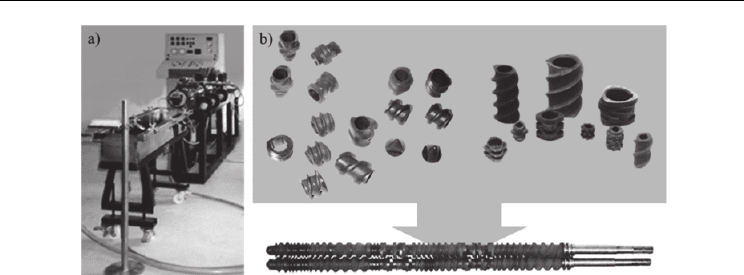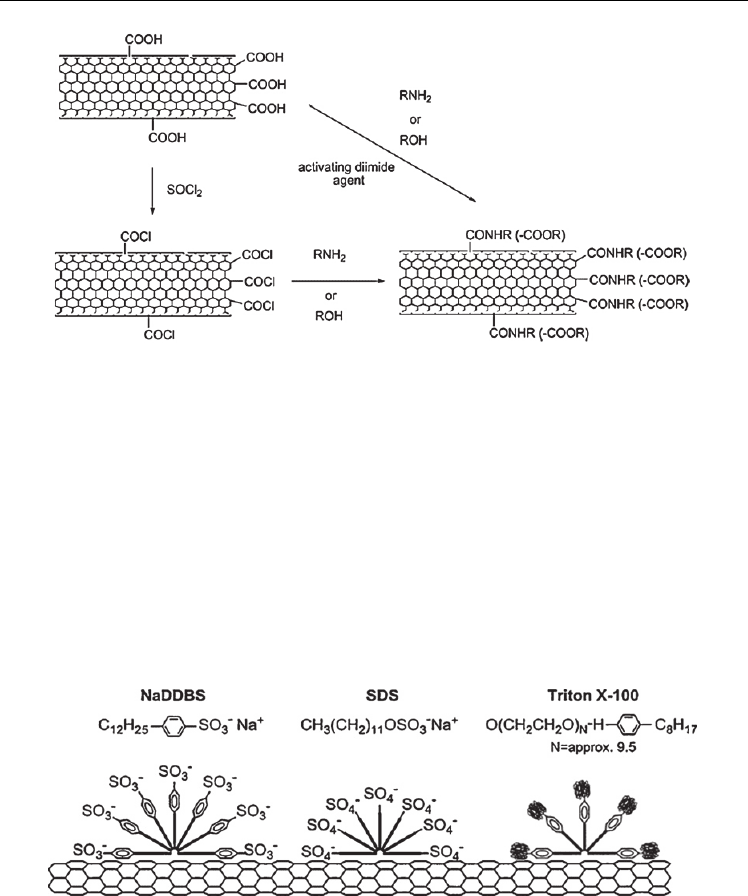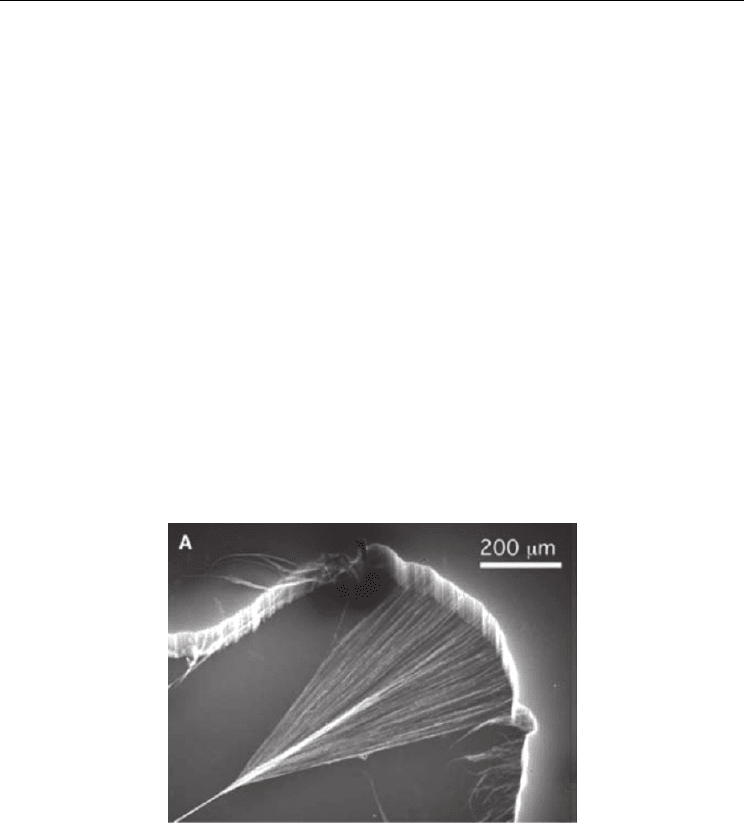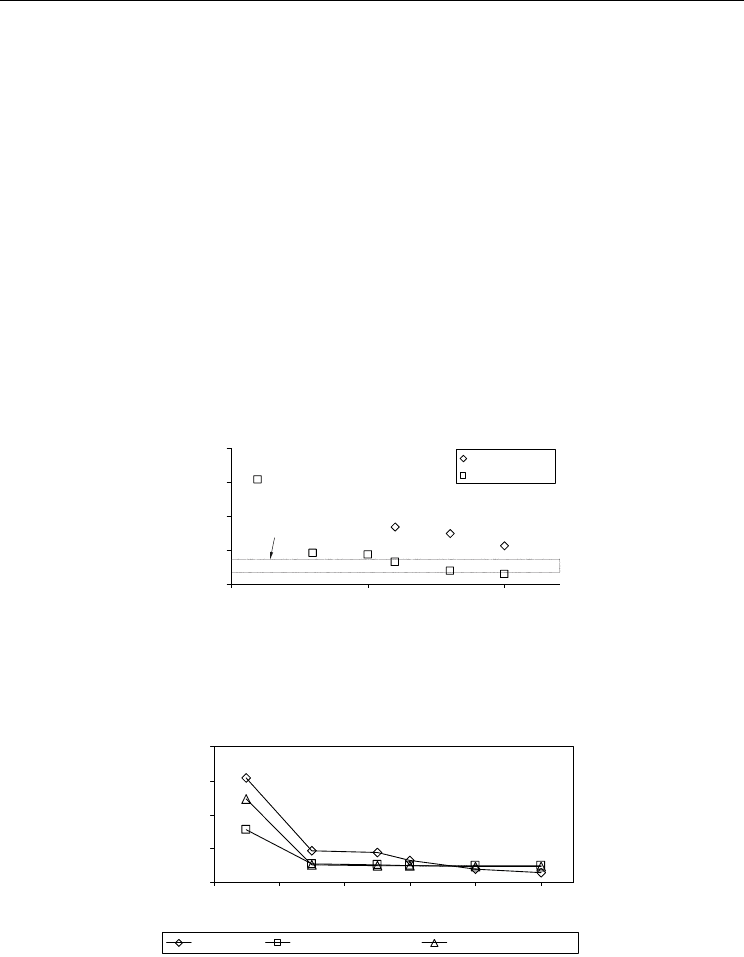Yellampalli S. (ed.) Carbon Nanotubes - Synthesis, Characterization, Applications
Подождите немного. Документ загружается.


Smart Materials and Structures Based on Carbon Nanotube Composites
377
Fig. 7. (a) Lab scale twin screw extruder and (b) screw modular design.
2.1.2 Dispersion of carbon nanotube based on functionalization
Covalent Functionalization
Functionalization of CNTs is an effective way to minimize nanotube interaction, which
helps to better disperse and stabilize the CNTs within a solvent or polymer matrix. There
are several approaches for functionalization of CNTs, including covalent and non-covalent
functionalizations.
In the case of covalent functionalization, the structure of CNTs is disrupted by changing sp
2
carbon atoms to sp
3
carbon atoms, and the physical properties of CNTs, such as electrical
and thermal conductivities, are influenced. However, functionalization of CNTs with
covalent bonding can improve dispersity in solvents and polymers. Generally, surface
modification starts from acid treatment, which create –COOH and –OH functional groups
on the CNT during oxidation by oxygen, reactive gas, sulfuric acid, nitric acid and other
concentrated acids or their mixtures. The quantitative amounts of –COOH and –OH
functional groups depend on oxidation conditions and oxidizing agent. Nanotube ends can
be opened and residual catalyst and amorphous carbons are removed during the oxidation
process (Spitalskya et al., 2010).
Carboxylic functionalized CNT surfaces can be further used to chemically attach other small
molecules or macromolecules through the reaction of the oxidation-induced functional
groups. One of the common chemical reactions with acid functionalized CNT is the
amidization, in which amide bond between amine group moieties is formed. One example is
the use of amino-functionalized MWCNTs in epoxy systems to yield improved mechanical
properties (Stevens et al., 2003). The improved mechanical performance in these
functionalized systems may reflect both the enhanced dispersion and an improved surface
interaction between CNT and polymer matrix. Further improvements in solubility can be
achieved by fluorination, again leading to improvements in both the stiffness and strength,
with the addition of 1 wt.% of oxidized and fluorinated SWCNTs. Also, it has been
established that the electrical properties of MWCNTs change after fluorination, leading to a
wide range of electrical structures, from insulating over to semiconducting and metallic-like
behavior (Seifert et al., 2000).
The chemically functionalized CNTs can produce strong interfacial bonds with many
polymers, allowing CNT-based nanocomposites to possess high mechanical and functional
properties.

Carbon Nanotubes - Synthesis, Characterization, Applications
378
Fig. 8. Schematic representation of amidization process which starts from oxidized CNTs
(Spitalsky et al., 2010).
Non-covalent Functionalization
A non-covalent method used to modify CNT surface is popular functionalization method
since it does not compromise the physical properties of CNTs. The electrostatic repulsion
provided by adsorbed surfactants stabilizes the nanotubes against the strong van der Waals
interactions between the nanotubes, hence preventing agglomeration. This repulsive and
attractive force balance creates a thermodynamically stable dispersion, which results in
separation of CNTs from the bundles into individual nanotubes. Anionic surfactants, such
as sodium dodecylsulfate (SDS) and sodium dodecylbenzene sulfonate (NaDDBS), are
commonly used to disperse CNT aggregation in polar media. The interaction between the
surfactants and the CNTs depends on the nature of the surfactants, such as its alkyl chain
length, headgroup size, and charge (Fig. 9) (Ma et al., 2010).
Fig. 9. Schematic diagram of surfactants adsorbed nanotube (Sahoo et al., 2010).
The physical interaction of polymers with CNTs to make specific formation can be explained
by the ‘wrapping’ mechanism which is π-stacking interactions between the polymer and the
nanotube surface. Usually, wrapping polymer consists of aromatic groups on main chain or
substitutional groups. For example, polyvinyl pyrrolidone (PVP) or polystyrene sulfonate
(PSS) wrapped CNT shows improved dispersity and electrical properties compared to those
of the individual components (Cheng et al., 2008).

Smart Materials and Structures Based on Carbon Nanotube Composites
379
Small angle neutron scattering studies demonstrated a non-wrapping conformation of
polymers in CNT dispersions. In these cases, different structures and compositions of
copolymers efficiently act as stabilizers. The suggested mechanism of non-wrapping is that
one of the blocks in block copolymers adsorbed to the nanotubes surfaces and another
solvophilic blocks act as a steric barrier that leads to the formation of stable dispersions of
individual CNTs above a threshold concentration of the polymer. A study of the
stabilization effect produced by different diblock or multiblock copolymers led to the
conclusion that selective interaction of the different blocks with solvent is essential in order
to obtain stable colloidal dispersions of CNTs (Nativ-Roth et al., 2007).
2.2 Control of carbon nanotube orientation
Similar to conventional fiber-reinforced composites, both mechanical properties and
functional properties, such as electrical, thermal and optical properties of CNT-polymer
composites are directly related to the alignment direction of CNTs in the matrix. Recently,
this topic has drawn much attention due to the advance in nanocomposite processing
techniques and the limitaions of randomly oriented, discontinuous nanotube composites.
2.2.1 Orientation of carbon nanotube by yarn formation
Recent advances in fabrication of CNTs allow to grow up to several millimeters in length,
and these CNTs are possibly aligned to continuous macroscopic SWCNT fibers (Fig. 10).
This provides an opportunity for fabricating continuous nanotube reinforced composites.
Fig. 10. SEM image of direct yarn formation from MWCNT forest (Zhang et al., 2004).
It has been reported that free-standing arrays of millimeter long, vertically aligned
multiwalled nanotubes exhibit supercompressibility, outstanding fatigue resistance, and
viscoelastic characteristics. Continuously aligned nanotube reinforced polydimethylsiloxane
(PDMS) composite shows remarkably enhanced compressive modulus and strength,
anisotropic characteristics, and damping capability (Ci et al., 2008).
2.2.2 Force field orientation
The first method developed to fabricate aligned CNTs in polymer matrix was by ‘‘cutting’’
an CNT-epoxy nanocomposite. This process is simply explained by the nature of rheology in

Carbon Nanotubes - Synthesis, Characterization, Applications
380
composite media on nanometer scales and flow-induced anisotropy produced by the
‘‘cutting’’ process. The fact that CNTs do not break and are aligned after cutting also
suggests that they have excellent mechanical properties along the nanotube direction.
However, the orientation of CNTs in CNT-epoxy composite is affected by the cut slice
thickness, since the alignment effect is only effective near the slice surface (Ajayan et al.,
1994).
A solution approach involved a SWCNT-dispersed surfactant solution (sodium dodecyl
sulfate, SDS) injected through a syringe needle into a polyvinyl alcohol (PVA) solution.
Because the PVA solution is more viscous than the SWCNT suspension, there is a shear
contribution in the flow at the tip of the syringe needle, the flow-induced alignment is
maintained by the PVA solution, and SWCNTs are rapidly stuck together as they are
injected out from the syringe. By pumping the polymer solution from the bottom, meter-
long ribbons are easily drawn, and well-oriented PVA-CNT composite fibers and ribbons
are formed by a simple process. It offers a method to align CNTs by a flow field (Vigolo et
al., 2000).
The more effective and convinient method in CNT orientation is uniaxially stretching of
polymer-CNT composite films. CNT-polymer composite films and fibers produced by any
process can be drawn uniaxially showing higher conductivity along the stretched direction
than the direction perpendicular to it. Also, the mechanical properties such as elastic
modulus and yield strength of composite fibers increased with draw ratio, and CNTs in the
composite fibers were better aligned. It is also possible to prepare aligned CNT composite
films by extruding the composite melt through a rectangular die and drawing the film prior
to cooling. For example, as compared to the drawn polystyrene (PS) film, the tensile strength
and modulus of the PS-MWCNT composite films were greater (Thostenson & Chou, 2002).
However, PS-MWCNT composites prepared by spin casting at high speed showed that
MWCNTs were aligned in specific angles relative to the radial direction: 45º and 135 º on
average. The presence of 2.5 vol.% MWCNTs doubles the tensile modulus and transforms
the film from insulating to conducting. It is also noted that the CNTs have higher orientation
than the polymer matrix during melt-drawing of the polymer-CNT composites
(Bhattachacharyya et al., 2003).
2.2.3 Electric or magnetic field induced orientation
Studies of SWCNT alignment using electric or magnetic fields have usually involved
epoxies or polyesters as matrices because of their low viscosity before cure. Under the
electric field, it was shown that both AC and DC electric fields can be used to induce the
formation of aligned CNT networks spanning the gap between electrodes in contact with
the dispersion. With increasing field strength, the quality of these networks and the
resulting bulk conductivity of the composite material can be enhanced(Martin et al., 2004).
However, at high CNT content, thus high viscosity of molten resin system, the magnetic
field-induced alignment of polymeric materials is more effective in CNT alignment. This
technique has been the focus of several research efforts, initiated by the first use of high
magnetic field to align MWCNTs in a polyester matrix to produce electrically conductive
and mechanically anisotropic composites. A high magnetic field is an efficient and direct
means to align CNTs. For example, to align MWCNT dispersed in methanol suspension, a
magnetic field greater than 7 T is demanded. For the CNT alignment in a polymer, even
higher magnetic field would be demanded because of high viscosity. Under a high magnetic

Smart Materials and Structures Based on Carbon Nanotube Composites
381
field of 10 T, it has been shown that MWCNTs were aligned in the monomer solution during
their polymerization and MWCNTs were aligned parallel to the magnetic field inside the
polymer matrix (Camponeschi et al., 2007). Recently, magnetic field aligned polycarbonate
(PC) and CNT-epoxy composites hae been reported and they suggested that aligning CNTs
in polymer matrices can improve mass transport property as well as electrical conduction. It
is also viewed that CNTs are better aligned in a PC matrix using magnetic field as compared
to an electric field (Abdalla et al., 2010).
2.2.4 Electrospinning induced orientation of carbon nanotube in polymeric nanofiber
Among several approaches to align nanotubes, the electrospinning technique has recently
ben used to incorporate CNTs in a polymeric matrix to form composite nanofibers,
combining the benefits of nanofibers with the merits of CNTs. Due to the sink flow and the
high extension of the electrospun jet, it is expected to align the nanotubes during the
electrospinning process, as was also predicted by a mathematical model. However, the
distribution and alignment of the nanotubes in the nanofibers are strongly associated with
the quality of the nanotube dispersion prepared before addition of the spinnable polymer
solution. Generally, well-dispersed MWCNTs were incorporated as individual elements
mostly aligned along the nanofiber axis. Conversely, irregular nanotubes were poorly
aligned and appeared curled, twisted, and entangled. It is also suggested that the nanofiber
diameter, the interaction between the spun polymer and the nanotubes and wetting ability
are important factors affecting the alignment and distribution of the nanotubes. This was
demonstrated by the difference in the alignment of SWCNTs in polyacrylonitrile (PAN) and
polylactic acid (PLA) nanofibers (Ko et al., 2003). More recent work to incorporate SWCNTs
into PEO nanofibers by the electrospinning process showed SWCNTs were embedded in
PEO in a more regular form since SWCNTs are much smaller and uniform in shape and size,
as compared to MWCNTs. On the other hand, their stronger tendency to bundle up into
coiled aggregates introduces a pronounced difficulty. Therefore, special attention is given to
the dispersion process, which is essential for successful alignment of the nanotubes by the
electrospinning process. Structural analysis of the composite nanofibers in terms of the
distribution and orientation of both the nanotubes and the polymer matrix has been studied
(Salalha et al., 2004).
Fig. 11. (a) Simple schematic presentation of electrospinning and (b) TEM image of SWCNT
aligned PEO nanofiber. Scale bar = 50 nm (Salalha et al., 2004)
3. Electrical properties of carbon nanotube composites
CNTs have clearly demonstrated their capability as fillers in conductive polymer
composites. Percolation theory predicts that there is a critical concentration at which

Carbon Nanotubes - Synthesis, Characterization, Applications
382
composites of insulating polymers become electrically conductive. According to the
percolation theory, conductivity of composite (
) can be estimated from the following
equation.
AVV
(1)
Where V is the CNT volume fraction, V
c
is the CNT volume fraction at the percolation
threshold, and A and β are fitted constant. The percolation threshold has been reported to
ranging from 0.0025 wt.% to several wt.%. The percolation threshold for the electrical
conductivity in CNT-polymer composites depends on degree of surface modification
dispersion, alignment, CNTs aspect ratio, polymer types and processing methods. The
electrical conductivity and percolation threshold of CNT-polymer composites are
summarized in Table 2.
Polym
er
matrix
CNT type Maximu
m filler
content
(wt.%)
Processin
g or
dispersio
n method
Maximum
electrical
Conductivit
y (S/m)
Percolation
threshold
(wt/%)
Reference
PS SWCNTs 2 Solution
mixing
10
-3
0.27 Chang et
al., 2006
PS Aligned
CNT
array
Drop
Casting
1330 Peng et al.,
2009
HDPE Acid-
SWCNTs
6 Extrusion 10
-1
~4 Zhang et.
al., 2006
LDPE Acid -
MWCNTs
10 Ball mill ~2 ~1-3 Gorrasi et
al., 2007
PP MWCNTs 10.7 Melt
mixing
4.6 1.1 Miˇcuˇsík
et al., 2009
PMM
A
SWCNTs 25 Coagulat
ion
10
-1
~1 Narayan et
al., 2009
PMM
A
MWCNTs 0.4 Solution
mixing
3
10
3
0.003 Kim et al.,
2004
PMM
A
Aligned
CNT
- Drop
casting
1250 - Peng et al.,
2009
PC MWCNT 15 Extrusion 20 1-2 Potschke et
al., 2002
PC PPE-
SWCNTs
10 Solution
mixing
4.8
10
2
0.11 Ramasubra
maniam et
al., 2003
Nylon
6
MWCNTs 10 Melt
mixing
0.1 2-2.5 Krause et
al., 2009
Nylon
6,6
MWCNTs 10 Melt
mixing
0.1 0.5-1 Krause et
al., 2009
PDMS MWCNTs 2.5 Ultrasoni
ca-tion
0.02 1.5 Khosla A
& Gray BL,
2009

Smart Materials and Structures Based on Carbon Nanotube Composites
383
PI MWCNTs 1.5 3.8310
-4
- Xiaowen et
al., 2005
PI Acid-
MWCNTs
7 Solution
mixing
3.810
-6
- Yuen et al.,
2007
PU MWCNTs 27 Solution
casting
2
10
3
0.009 Koerner et
al., 2005
PET SWCNTs 5 Melt
mixing
~1 0.024 Hernandez
et al., 2009
Epoxy Aligned
SWCNT
5 Solution
casting
~10
-5
0.5 Qing et al.,
2008
Epoxy Silane-
MWCNT
1 Solution
mixing
1.67
10
-2
- Lee et al.,
2011
Epoxy MWCNT 8 3-roll
mill
2.310
4
0.0117 Iosif et al.,
2009
Epoxy SDS-
MWCNTs
0.5 Bulk
mixing
2.5
10
-7
- Santos et
al., 2008
Nafion SWCNTs 18 Solution
mixing
3.2
10
3
- Landi et
al., 2002
Table 2. Electrical properties of CNT-polymer composites
4. Smart, multifunctional applications of carbon nanotube composites
CNT-based polymer composites have found numerous multifunctional applications owing
to their capability to serve as reinforcing, lightweighting agents and a material platform for
electrostatic discharging, electromagnetic interference shielding, radar absorbing,
mechanical/chemical sensing, energy harvesting, and flame retardation. Smart applications
can be categorized into sensing and actuation, and this chapter will primary focus on the
review of research on electromechanical sensing using CNT-based polymer composites. The
studies on sensors and actuators based on CNTs and their composites up to 2007 are well
summarized by Li et al. (Li et al., 2008), and this chapter primarily presents more recent
studies.
4.1 CNT Nanocomposites for electromechanical sensing
Electromechanical sensing and structural health monitoring typically utilize the
piezoresistive behavior of the electrically conductive network formed by CNTs in polymer
matrices, that is, the behavior characterized by a change in resistivity with respect to the
structural deformation incurred by an external load. For example, when a CNT
nanocomposite is subjected to a tensile load, the percolated CNT network is disrupted,
resulting in an increase in resistivity. The variation in resistivity under a load is attributed to
the variation in contact configurations and tunnelling distances among the contacting CNTs
upon nanocomposite deformation.
Initial studies on piezoresistivity of conductive CNT network involved free-standing CNT
films or sheets, also known as “buckypapers.” CNT buckypapers are typically made by
filtration, similar to the papermaking process, where the CNTs are uniformly dispersed in a
solvent, usually with the aid of surfactants, and subsequently passed through a filtering
paper on which the CNTs are eventually deposited, dried, and detached. The CNT sheets

Carbon Nanotubes - Synthesis, Characterization, Applications
384
were bonded to the surfaces of various substrates, including brass (Li et al., 2004; Vemuru et
al., 2009), aluminium (Li et al., 2004), and fiberglass (Kang et al., 2006). While these substrates
were loaded under tension or flexure, the resistance between two electrodes attached to the
CNT sheet was measured in situ. Most of these studies employed isotropic, randomly
oriented CNT networks, and showed that the resistance increase linearly under tension and
decreased linearly under compression. The isotropy allows multi-directional, multi-location
strain measurements.
It has been reported that CNTs can be added to various materials, including general-
purpose thermoplastics and thermosets, specialty polymers, such as polyvinylidene fluoride
(PVDF) and shape memory polymers, elastomers, and concrete, and utilize the
piezoresistivity of the nanocomposites for strain or pressure sensing.
4.1.1 Thermoplastic-based nanocomposites
The research group at the University of Cincinnati (Kang et al., 2006) reported
comprehensive research work on strain sensing using buckypapers and SWCNT-
polymethylmethacrylate(PMMA) composites. Fig. 12(a) shows the strain response of a
SWCNT buckypaper sensor, which shows higher sensitivity in the linear bending range.
However, it shows saturated strain behavior above 500 microstrains, which is probably
attributed to the slippage among CNT bundles due to the weak van der Waals interactions
at nanotube interfaces. When the sensor is compressed, the individual CNTs do not slip as
much as compared to the tension case, resulting in the lack of saturation. Fig. 12(b) shows
the strain response of composite sensor at varying CNT loadings. Although the composite
strain sensors show lower sensitivities than buckypaper, they show linear symmetric strain
response trends in both compression and tension. The interfacial bonding between CNTs
and the polymer reduces slip and effectively increases the strain in the sensor.
(a) Buckypaper
(b) SWCNT-PMMA composite
Fig. 12. Piezoresistive response of: (a) buckypaper sensor and (b) SWCNT-PMMA composite
sensor (Kang et al., 2006a, 2006b)
Pham et al. (Pham et al., 2008) reported the development of conductive, MWCNT-filled,
polymer composite films that can be used as strain sensors with tailored sensitivity. The
electrical resistance of MWCNT-PMMA composite films subjected to tensile strains was
measured, and the potential applications of the films as strain sensors with a broad range of
tunable sensitivity were investigated. The surface resistivity of the films was observed to
increase with increasing tensile strain, which is due to the reduction in conductive network
density and increase in inter-tube distances induced by applied strains. The highest
sensitivity achieved in this study was almost an order of magnitude greater than

Smart Materials and Structures Based on Carbon Nanotube Composites
385
conventional resistance strain gages (Fig. 13). A semi-empirical model, based on the
percolation theory, was developed to identify the relationship between applied strain and
sensitivity factor (Fig. 14). Not only can the sensitivity be tailored over a broad, but also it
can be increased significantly be having the conductive filler content approach the
percolation threshold.
Zhang et al. (Zhang et al., 2006) presented a study on MWCNT-polycarbonate(PC)
composites as multifunctional strain sensors, where a 5 wt.% composite showed
instantaneous electrical resistance response to linear and sinusoidal dynamic strain inputs
and a sensitivity of ~3.5 times that of a typical strain gage. Billoti et al. (Billoti et al., 2010)
presented a study on thermoplastic polyurethane (TPU) fibers containing MWCNTs,
fabricated via an extrusion process, which demonstrated a tuneable level of electrical
conductivity. The observation of Arrhenius dependence of zero-shear viscosity and the
assumption of simple inverse proportionality between the variation of conductivity, due to
network formation, and viscosity allow a universal plot of time variation of conductivity to
be composed, which is able to predict the conductivity of the extruded fibers. The same
nanocomposite fibers also demonstrated good strain sensing abilities, which were shown to
be tunable by controlling the extrusion temperature.
Fig. 13. Comparison of sensitivity factors between MWCNT-PMMA films and conventional
resistance strain gages
Fig. 14. Calculated and experimental sensitivity factors of MWCNT-PMMA films
Abraham et al. (Abraham et al., 2008) reported the development and characterization of a
CNT-PMMA nanocomposite flexible strain sensor for wearable health monitoring
applications. These strain sensors can be used to measure the respiration rhythm which is a
0
5
10
15
20
0510
MWNT wt.%
Sensitivity Fact
o
Dry blended
Solution prepared
MWNT wt.%
Sensitivity Factor
Sensitivity range for
conventional strain gages
0
5
10
15
20
0246810
MWNT Loading (wt.%)
Sensitivity Fact
o
Experimental Calculated (Vc = 0.75%) Calculated (Vc = 0.80%)
MWNT Loading (wt.%)
Sensitivity Factor

Carbon Nanotubes - Synthesis, Characterization, Applications
386
vital signal required in health monitoring. A number of strain sensor prototypes with
different CNT compositions have been fabricated and their characteristics for both static as
well as dynamic strain have been measured. Bautista-Quijanoa et al. (Bautista-Quijanoa et al.,
2010) reported the electrical and piezoresistive responses of thin polymer films made of
polysulfone (PSF) modified with 0.05–1% w/w MWCNTs. Gage factors were measured for
films with 0.2–1% CNT weight loadings. The films were then bonded to macroscopic
aluminum specimens and evaluated as strain sensing elements during quasi-static and
cycling tensile loading. Excellent piezoresistive capabilities were found for films with
MWCNT loadings as low as 0.5% w/w.
CNTs were added to a piezoelectric polymer, PVDF, to for various smart applications,
including strain sensing. Deshmukh et al. (Deshmukh et al., 2009) presented an experimental
evidence of the creation of an electrostrictive response in PVDF by addition of small
quantities of CNTs. It was demonstrated that the piezoelectric response of nanocomposites
can be dramatically enhanced through addition of conductive nanoparticles such as CNTs
without additional weight penalties. Most importantly, these improvements were achieved
at much lower actuation voltages and were accompanied by an increase in both mechanical
and dielectric properties. In the work by Kim et al. (Kim et al., 2008), CNTs were included in
a PVDF matrix to enhance the properties of PVDF. The CNT-PVDF composite was
fabricated by solvent evaporation and melt pressing. The inclusion of CNT allowed the
dielectric properties of PVDF to be adjusted such that lower poling voltages can be used to
induce a permanent piezoelectric effect in the composite. The CNT-PVDF composites were
mounted on the surface of a cantilever beam to compare the voltage generation of the
composite against homogeneous PVDF thin films.
4.1.2 Thermoset-based nanocomposites
The primary types of thermosets used as the matrices for strain sensing nanocomposites
include epoxy, vinyl ester, and polyimide, among which epoxies are most popular. In the
work by Wichmann et al. (Wichmann et al., 2009), electrically conductive epoxy based
nanocomposites based on MWCNTs and carbon black were investigated concerning their
potential for strain sensing applications with electrical conductivity methods. It was found
that the nanocomposites exhibited a distinct resistance vs. strain behavior in the regime of
elastic deformation, which is in good agreement with prevalent theories about charge carrier
transport mechanisms in isolator/conductor composites. Applying an analytical model, it
was shown that the piezoresistivity of nanocomposites may contribute valuable information
about the conductive network structure and charge carrier transport mechanisms occurring
in the nanocomposites. The authors also developed a direction-sensitive bending strain
sensor consisting of a single block of MWCNT-epoxy composite by generating a gradient in
electrical conductivity throughout the material (Wichmann et al., 2008).
Zhang et al. (Zhang et al., 2007) demonstrated a simple, effective and real-time diagnostic,
and repair technique featuring MWCNTs that are infiltrated into epoxy. It was shown that
by monitoring volume and through-thickness resistances, one can determine the extent and
propagation of fatigue-induced damage such as crack and delamination growth in the
vicinity of stress concentrations (Fig. 15). The conductive nanotube network also provides
opportunities to repair damage by enabling fast heating of the crack interfaces; the authors
show up to 70% recovery of the strength of the undamaged composite.
